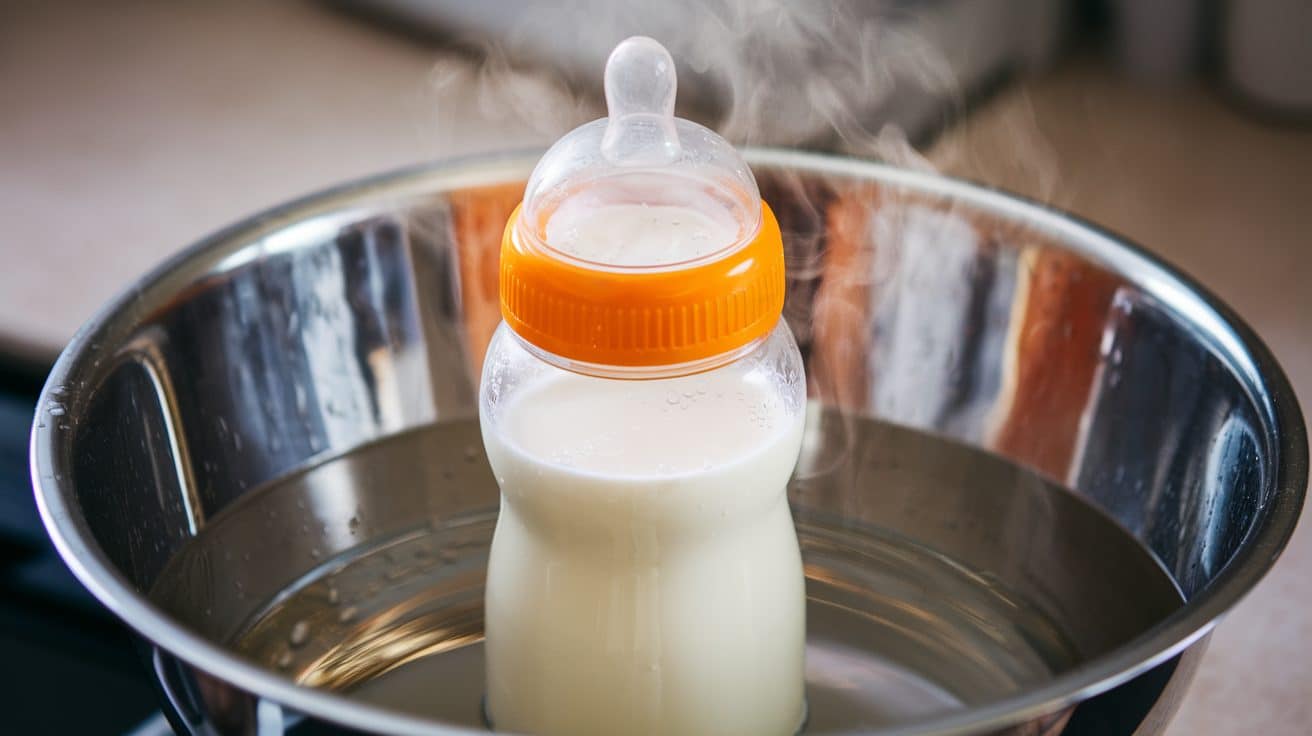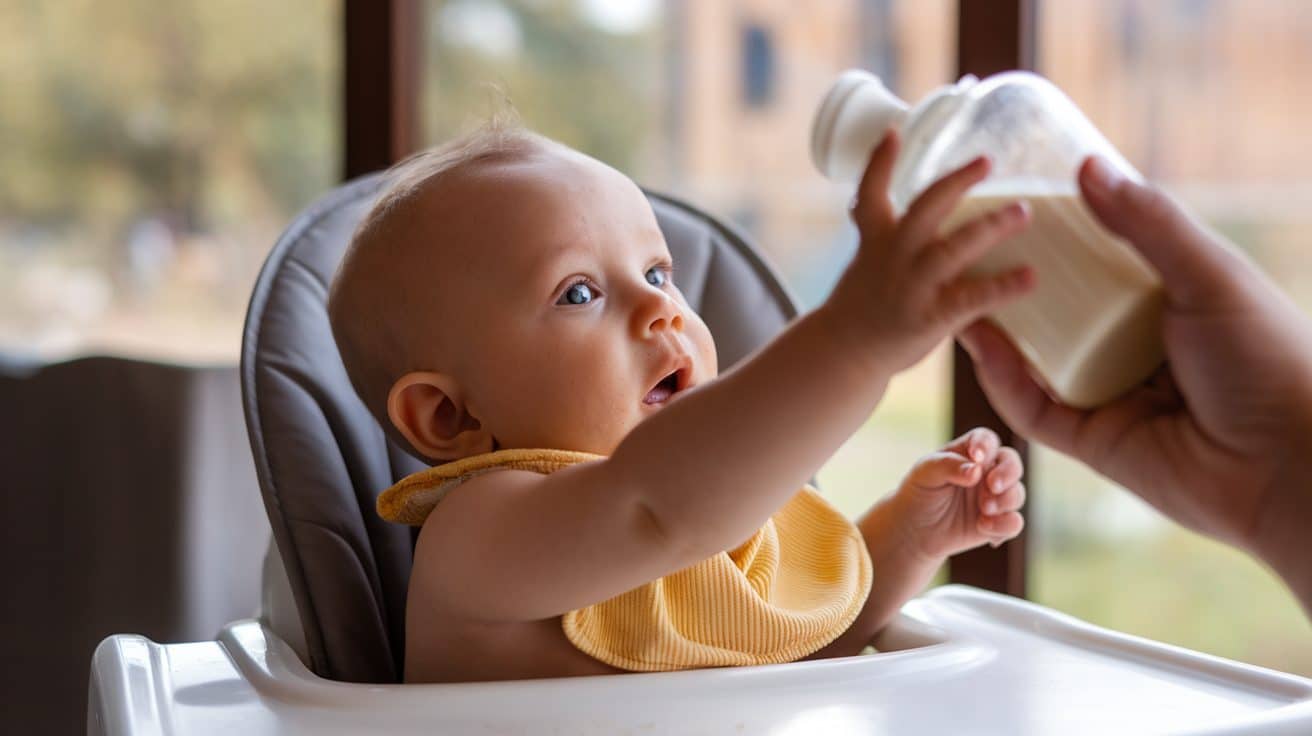Is your baby turning away from the bottle, moving restlessly, or getting upset during feeding time?
While the World Health Organization suggests breastfeeding as the primary feeding method for the first 6 months, many parents need to use bottles for various reasons.
But there’s good news: squirming during bottle feeds often has simple explanations and solutions.
From the bottle type to feeding positions, understanding why your baby squirms can help you make feeding time more comfortable for both of you.
Let’s look at the most common reasons and what you can do about them.
What is Squirming While Bottle Feeding?
Squirming during bottle feeding refers to your baby’s movements, such as wriggling, arching their back, pulling away, or shifting their body.
These behaviors often indicate discomfort or frustration during feeding. While some movement is natural, excessive squirming can signal various issues that may be affecting your baby’s feeding experience.
Squirming might occur when your baby is struggling with factors like milk flow, feeding position, or physical discomfort. They could also be reacting to environmental stimuli or changes in their bottle or teat.
Behavioral Factors Behind Squirming
Understanding your baby’s behavior during feeding can help solve the puzzle of squirming. Let’s look at three key behavioral patterns that might explain why your baby moves around during bottle feeds.
When Squirming Isn’t Just Hunger
Your baby’s squirming might not always mean they’re hungry. Babies naturally want to suck for various reasons:
- When they feel tired
- If they’re bored
- To soothe themselves
- When feeling uncomfortable
Sometimes, what looks like hunger is actually your baby’s way of expressing other needs.
During their first three months, babies have a strong sucking reflex. This means they might accept a bottle even when they’re not hungry, leading to fussing and squirming once feeding begins.
Recognize Feeding Aversion
Sometimes babies develop negative feelings about bottle feeding based on past experiences. Signs of feeding aversion include:
- Refusing the bottle even when hungry
- Getting upset at the sight of the bottle
- Taking only small amounts and turning away
- Feeding better when almost asleep
This often happens when feeding has been stressful or uncomfortable in the past.
While doctors might point to reflux or milk sensitivities, often the issue stems from how feeding sessions are managed.
The Distraction Factor
Once your baby reaches 4 months, they become more aware of their surroundings. This new awareness can affect feeding in several ways:
- Looking around during feeds
- Stopping to watch activities nearby
- Trying to play instead of eating
- Having trouble staying focused on feeding
External Factors That Can Cause Squirming During Bottle Feeding
Beyond behavioral and physical factors, several other situations might cause your baby to squirm during feeds. Let’s explore these common but often overlooked causes.
When Teething Interferes
When your baby’s teeth are coming in, feeding time can become challenging. Watch for these signs:
- Pulling away from the bottle suddenly
- Biting on the teat instead of sucking
- Being more fussy than usual during feeds
- Touching their gums or face more often
Milk Temperature Matters
The temperature of your baby’s milk plays a big role in their comfort. Before offering the bottle, always check the milk temperature because:
- Milk that’s too cold might cause tummy discomfort
- Too-warm milk could startle your baby
- Unexpected temperature changes can lead to feeding refusal
- Temperature issues often cause immediate squirming
Environmental Effects
Your baby might squirm due to their surroundings. Common triggers include:
- Strong or sudden noises
- Very bright lighting
- Scratchy clothing tags
- Too much movement around them
Sometimes, simply adjusting these environmental factors can make a notable difference in your baby’s feeding behavior.
Try creating a calm, comfortable space for feeding times, with soft lighting and minimal distractions.
How to Reduce Squirming During Bottle Feeding?
Making bottle feeding more comfortable for your baby often requires a combination of approaches. Here’s how you can help your little one enjoy peaceful feeding times.
Choose the Right Feeding Equipment
Choosing suitable bottles and teats makes a significant difference. Your baby’s bottle should be easy to hold and clean. For the teat, consider these key factors:
- Size should match your baby’s mouth and age
- Flow speed needs to suit your baby’s sucking ability
- Materials should be safe and flexible
- Look for vented options to reduce air intake
Most importantly, watch how your baby responds to different teats. Some babies need to try several types before finding one that works well.
Get the Feeding Position Right
Your feeding position affects how comfortably your baby can drink. Hold your baby semi-upright, supporting their head and neck.
If your baby usually breastfeeds, try mimicking that position with the bottle. This familiar angle often helps reduce squirming and makes feeding more natural.
Manage Milk Flow
Pay attention to how your baby handles the milk flow. If they’re coughing or having milk spill from their mouths, the flow might be too fast.
When they seem frustrated and pull away frequently, the flow might be too slow. Remember not to tighten the bottle ring too much – this can create a vacuum that makes feeding harder.
Create a Peaceful Feeding Environment
A calm setting helps your baby focus on feeding. Try these simple steps:
- Find a quiet space away from noise
- Keep lighting soft and comfortable
- Ensure room temperature is just right
- Remove any uncomfortable clothing or tags
Remember to relax yourself – your baby can sense your emotions. If you’re feeling stressed, take a deep breath and try to create a peaceful moment for both of you.
Every baby is different, and what works for one might not work for another. Give these solutions time to work, and don’t hesitate to adjust your approach based on your baby’s response.
When to Consult a Pediatrician?
Squirming during bottle feeding is usually normal, but sometimes it may signal a need for expert advice. Here’s when to contact your pediatrician:
Signs You Should Call Your Pediatrician
- Regularly spits up large amounts of milk
- Appears uncomfortable during or after feeds
- Refuses multiple feeds despite hunger
- Shows signs of weight loss or poor growth
- Seems consistently unhappy during feeding
Potential Medical Considerations
- Reflux: If your baby strains, spits up, or cries during or after feeds, reflux might be the cause.
- Milk Sensitivities: Watch for fussiness, skin rashes, or digestive changes after feeding.
- Other Health Concerns: Your pediatrician can assess sucking, swallowing coordination, and overall development.
Your pediatrician is there to help. They can examine your baby, suggest formula changes if needed, or prescribe medication to help make feeding more comfortable.
Don’t hesitate to seek their advice if you’re concerned about your baby’s feeding behavior.
Final Thoughts
Watching your baby squirm during bottle feeding can be concerning, but remember that this behavior often has simple solutions.
Whether it’s adjusting the bottle type, finding the right feeding position, or creating a calmer environment, small changes can make a big difference in your baby’s feeding comfort.
Pay attention to your baby’s cues and trust your parental instincts – you know your little one best.
While most feeding issues are resolved with proper adjustments at home, don’t hesitate to consult your pediatrician if you have ongoing concerns.
Keep trying different approaches until you find what helps your baby feed comfortably.
Frequently Asked Questions (FAQs)
Why Is My Baby Squirming During Bottle Feeding?
Your baby might squirm due to discomfort from the bottle, milk flow, or feeding position. It could also be caused by gas, reflux, or a need for a break.
Why Does My Baby Thrash Around While Bottle Feeding?
Thrashing during feeding can result from discomfort, an improper latch, gas, or overstimulation. It may also happen if the milk flow is too fast or slow for your baby.
Is It Normal for Babies to Squirm While Feeding?
Yes, some squirming is normal as babies explore their environment or experience discomfort. However, if it’s persistent or accompanied by other signs, it may be worth adjusting the feeding setup.
Why Is My Baby so Fidgety when Feeding?
Fidgeting can occur due to distractions, hunger cues not being met, gas, or discomfort from the bottle, position, or milk temperature. Adjusting these factors can help reduce fidgeting.














